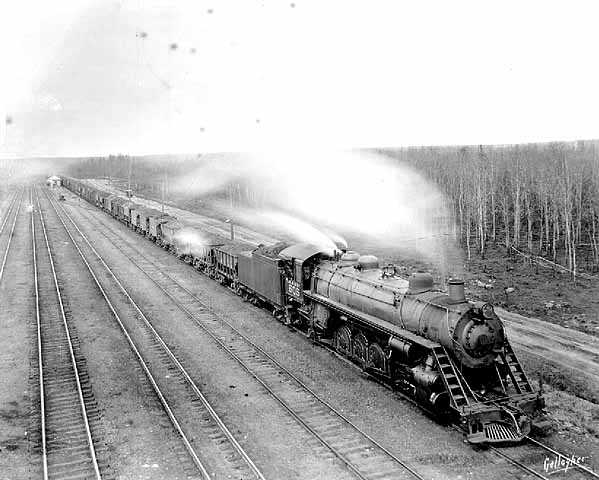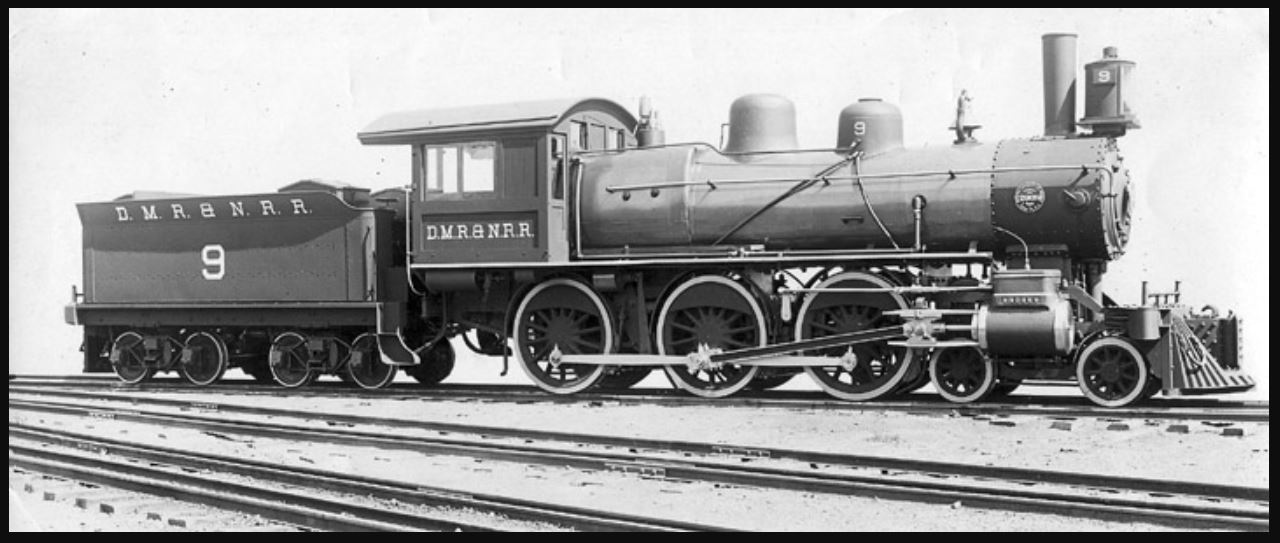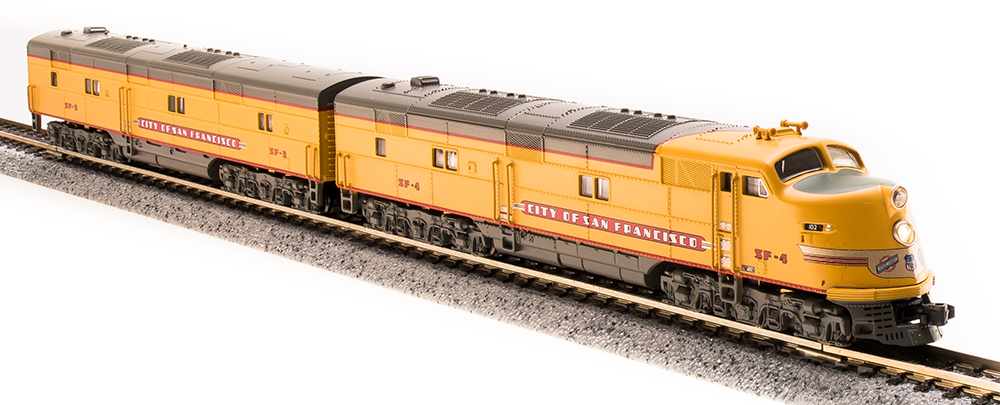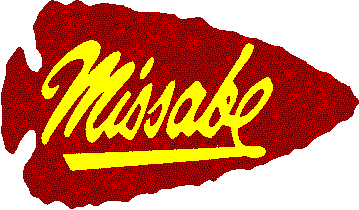Company History: The DM&N was built in 1891 and 1892 to move iron ore from Minnesota’s Missabe Range to the lake port at Alllouez in Superior, Wisconsin. Note that Missabe has a number of different spellings so we’ll go with the railroad’s version. The latter was reached via trackage rights on the Duluth & Winnipeg but it wasn’t long before the DM&N built their own line to their own docks at Duluth. In the wake of the panic of 1893, John D. Rockefeller assumed control of the railroad and the mines it served. The Missabe Range turned out to be far richer than the neighboring Vermilion Range (whose earlier railroads had the opportunity but no interest in building into the Missabe.) DM&N’s docks in Duluth had to be tripled in size. In 1901, Rockefeller sold his stake in DM&N to U.S. Steel who also purchased the Duluth & Iron Range Rail Road. The two continued to operate separately although gradually certain management functions were combined. In 1930, DM&N leased the D&IR and operations were combined. By 1937, DM&N had 540 miles of line connecting iron mining operations in Coloraine, Hibbing and Virginia, Minnesota with the ports of Duluth and Superior. They had 131 locomotives including a dozen 2-8-8-2’s and sixteen 2-10-2’s. They even had a quartet of 0-10-0 heavy switchers. In 1937, the Spirit Lake Transfer Railway merged with DM&N to form Duluth Missabe & Iron Range. The Duluth & Iron Range, which was still under lease, was absorbed the following year.
Successor/Parent History: The DM&IR was born in 1937 with the merger of the Duluth Missabe & Northern and the Spirit Lake Transfer Railway. The DM&N had leased the Duluth & Iron Range since 1930 and both were owned by United States Steel. The D&IR was absorbed by the DM&IR in 1938.
The DM&IR ran from the twin ports of Duluth and Superior on the Minnesota-Wisconsin border at the tip of Lake Superior, and Two Harbors, Minnesota north and northwest into the Vermilion and Missabe Ranges of northeast Minnesota. Total mileage was 357. Several of the mainlines are double track and DM&IR operated them with left-hand running. The majority of DM&IR traffic over the decades has been iron ore.
Because DM&IR has traditionally had the heaviest average trains in the nation, their steam fleet had some real monsters. 2-8-8-4 Yellowstones were the biggest. Single Yellowstones were regularly assigned to pull 18,000 ton ore trains on some of the flatter districts. Their biggest yard switchers were 0-10-0’s. DM&IR was the last of the US Steel railroads to dieselize (in 1959) so as the other roads in the US Steel family dieselized, they sent the cream of their steam fleets to the DM&IR. Mikados came from EJ&E. Bessemer & Lake Erie sent their huge Texas-type 2-10-4’s and the Union Railroad sent their 0-10-2’s. That’s not a typo, they had 0-10-2’s. They were used to replace older mallets in pusher service then ended their careers switching the ore docks.
DM&IR dieselized with SD9’s (running short hood forward), SD18’s and ultimately SD38’s. They were one of a handful of Class One railroads to get through the transition era without ever buying cab unit. The SD38 has just 2000 horsepower but has nearly the same tractive effort as an SD40 at low speeds. Many roads bought them to shove trains over the crest in hump yards, but three of the US Steel railroads used them for low speed road service. By the mid-70s, DM&IR had 98 diesels. Many years later, DM&IR was one of the roads to buy rebuilt former SP Tunnel Motors.
Raw iron ore was hauled in 70 ton 24’ long ore cars. The same cars with extension boards are used to haul Taconite. Taconite is low grade ore that is crushed to dust, then combined with bentonite clay and rolled into little balls. It’s less dense than raw ore, doesn’t require further grading, and resists freezing to the cars. This allows all-rail movement of taconite to the steel mills when the Great Lakes freeze over. In the 70s, DM&IR began draw-barring sets of 4 ore cars together which saved on brake hose failure and lowered the tare weigh
t somewhat. They referred to these sets as “mini-quads.” US Steel transferred B&LE and DM&IR to a subsidiary called Transtar. In 2001, the Transtar roads were sold to Great Lakes Transportation. In 2004, DM&IR and B&LE were sold to Canadian National.
The DM&IR ran from the twin ports of Duluth and Superior on the Minnesota-Wisconsin border at the tip of Lake Superior, and Two Harbors, Minnesota north and northwest into the Vermilion and Missabe Ranges of northeast Minnesota. Total mileage was 357. Several of the mainlines are double track and DM&IR operated them with left-hand running. The majority of DM&IR traffic over the decades has been iron ore.
Because DM&IR has traditionally had the heaviest average trains in the nation, their steam fleet had some real monsters. 2-8-8-4 Yellowstones were the biggest. Single Yellowstones were regularly assigned to pull 18,000 ton ore trains on some of the flatter districts. Their biggest yard switchers were 0-10-0’s. DM&IR was the last of the US Steel railroads to dieselize (in 1959) so as the other roads in the US Steel family dieselized, they sent the cream of their steam fleets to the DM&IR. Mikados came from EJ&E. Bessemer & Lake Erie sent their huge Texas-type 2-10-4’s and the Union Railroad sent their 0-10-2’s. That’s not a typo, they had 0-10-2’s. They were used to replace older mallets in pusher service then ended their careers switching the ore docks.
DM&IR dieselized with SD9’s (running short hood forward), SD18’s and ultimately SD38’s. They were one of a handful of Class One railroads to get through the transition era without ever buying cab unit. The SD38 has just 2000 horsepower but has nearly the same tractive effort as an SD40 at low speeds. Many roads bought them to shove trains over the crest in hump yards, but three of the US Steel railroads used them for low speed road service. By the mid-70s, DM&IR had 98 diesels. Many years later, DM&IR was one of the roads to buy rebuilt former SP Tunnel Motors.
Raw iron ore was hauled in 70 ton 24’ long ore cars. The same cars with extension boards are used to haul Taconite. Taconite is low grade ore that is crushed to dust, then combined with bentonite clay and rolled into little balls. It’s less dense than raw ore, doesn’t require further grading, and resists freezing to the cars. This allows all-rail movement of taconite to the steel mills when the Great Lakes freeze over. In the 70s, DM&IR began draw-barring sets of 4 ore cars together which saved on brake hose failure and lowered the tare weigh
t somewhat. They referred to these sets as “mini-quads.” US Steel transferred B&LE and DM&IR to a subsidiary called Transtar. In 2001, the Transtar roads were sold to Great Lakes Transportation. In 2004, DM&IR and B&LE were sold to Canadian National.
Brief History: The U.S. is a country of 50 states covering a vast swath of North America, with Alaska in the northwest and Hawaii extending the nation’s presence into the Pacific Ocean. Major Atlantic Coast cities are New York, a global finance and culture center, and capital Washington, DC. Midwestern metropolis Chicago is known for influential architecture and on the west coast, Los Angeles' Hollywood is famed for filmmaking.
Item Links: We found: 2 different collections associated with Duluth Missabe & Northern - Railroad
- Collection N Scale Model Trains: 3 different items.
- Collection Transportation Companies: 1 different items.
Item created by: gdm on 2017-10-10 09:56:26. Last edited by George on 2024-10-27 07:57:51
If you see errors or missing data in this entry, please feel free to log in and edit it. Anyone with a Gmail account can log in instantly.
If you see errors or missing data in this entry, please feel free to log in and edit it. Anyone with a Gmail account can log in instantly.










